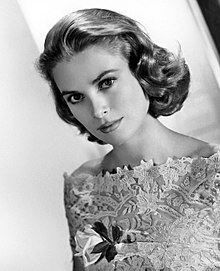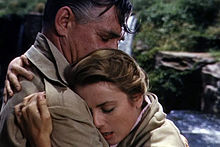Career[edit]
Main article: Film career of Grace Kelly
Early years[edit]
Despite her parents' disapproval, Kelly decided to pursue her dreams of being an actress. Her father was particularly displeased with her decision; he viewed acting as "a slim cut above streetwalker."[7]
To start her career, she tried to get admitted into the American Academy of Dramatic Arts in New York. In her audition, she used a scene from her uncle's 1923 play The Torch-Bearers. Although the school had already met its semester quota, Kelly obtained an interview with the school's admission officer, Emile Diestel, and was admitted through the influence of her uncle George.[7]. Kelly began her first term the following October. While at school, she lived in Manhattan's Barbizon Hotel for Women, a prestigious establishment which barred men from entering after 10 pm, and she worked as a model to support her studies.
She worked diligently and practiced her speech by using a tape-recorder. Her early acting pursuits led her to the stage, most notably a Broadway debut in Strindberg's The Father alongside Raymond Massey. At 19, her graduation performance was as Tracy Lord in The Philadelphia Story.[7]
Television producer Delbert Mann cast Kelly as Bethel Merriday, in an adaptation of the Sinclair Lewis novel of the same name; this was her first of nearly sixty live television programs.[7] Success on television eventually brought her a role in a major motion picture. Kelly made her film debut in a small role in the 1951 film Fourteen Hours. She was noticed during a visit to the set by Gary Cooper, who subsequently starred with her in High Noon. Cooper was charmed by Kelly and said that she was "different from all these actresses we've been seeing so much of."
However, her performance in Fourteen Hours was not noticed by critics and did not lead to her receiving other film acting roles. She continued her work in the theater and on television,[8]although she lacked "vocal horsepower" and would likely not have had a lengthy stage career.[7] She had various roles on television shows produced by NBC and CBS. Kelly was performing in Colorado's Elitch Gardens when she received a telegram from Hollywood producer Stanley Kramer offering her a co-starring role opposite Gary Cooper in High Noon.
Acting career for Metro-Goldwyn-Mayer[edit]
| This section needs additional citations for verification. (October 2014) |
Director John Ford had first noticed Kelly in a 1950 screen test. The studio flew Kelly to Los Angeles to audition in September of 1952, and Ford said that Kelly showed "breeding, quality and class."[7] She was hired for the role and was offered a seven-year contract with a salary of $850 a week. Kelly signed the deal under two conditions: That every two years she could get time off to do theater performances, and that she could live in New York City at the now-landmarked Manhattan House (200 E. 66th Street).[11][7]
Two months after signing her contract, Kelly and the cast arrived in Nairobi to begin production of the film Mogambo. Gene Tierney was initially cast in the role, but she had to drop out at the last minute owing to personal issues.[12][13] Upon getting the role, Kelly told Hollywood columnist Hedda Hopper, "Mogambo had three things that interested me. John Ford, Clark Gable, and a trip to Africa with expenses paid. If Mogambo had been made in Arizona, I wouldn't have done it."[14] A break in the filming schedule afforded Kelly and Mogambo co-star Ava Gardner a visit to Rome.[15] Kelly's role as Linda Nordley in MGM's production of Mogambo garnered her a Golden Globe Award for Best Supporting Actress and her first Academy Award nomination for Best Supporting Actress.
After the success of Mogambo, Kelly starred in a TV play The Way of an Eagle with Jean-Pierre Aumont, before being cast in the film adaptation ofFrederick Knott's Broadway hit Dial M for Murder. Director Alfred Hitchcock also saw the 1950 screen test[7] and took full advantage of Kelly's beauty on-camera. Hitchcock was one of Kelly's last mentors in the film industry.
Kelly began filming scenes for her next film The Bridges at Toko-Ri in January 1954 with William Holden. She played the role of Nancy, the wife of naval officer Harry (Holden), who was a minor but pivotal character in the story. A film review that was released 12 months later, the The New Yorkerremarked on the apparent on-screen chemistry between Kelly and Holden, and took note of Kelly's delivery of her performance "with quiet confidence."
Kelly unhesitatingly turned down the opportunity to star alongside Marlon Brando in On the Waterfront.[citation needed] Eva Marie Saint, who replaced Kelly won an Academy Award for that role. Kelly committed instead to the role of Lisa Fremont in Rear Window. Said Kelly, "All through the making ofDial M for Murder, he [Hitchcock] sat and talked to me about Rear Window all the time, even before we had discussed my being in it."[16] During the shooting of Dial M for Murder, Kelly and Hitchcock shared a close bond of humor and admiration, although minor strife sometimes emerged on set.
Kelly's new co-star, James Stewart, was highly enthusiastic about working with her.[17] The role of Lisa Fremont, a wealthy Manhattan socialite and model, was unlike any of the previous women Kelly had played. For the very first time, she portrayed an independent, career-driven woman. Stewart played a speculative photographer with a broken leg, bound to a wheelchair and so reduced to curiously observing the happenings outside his window. Just as he had done earlier, Hitchcock provided the camera with a slow-sequenced silhouette of Kelly, along with a close-up of the two stars kissing, and finally lingering closely on her profile. With the film's opening in October 1954, Kelly was again praised. Variety's film critic remarked on the casting, commenting on the "earthy quality to the relationship between Stewart and Miss Kelly. Both do a fine job of the picture's acting demands."[18]
Kelly won the role of Bing Crosby's long-suffering wife, Georgie Elgin, in The Country Girl, after a pregnant Jennifer Jones bowed out. Already familiar with the play, Kelly was highly interested in the part. To do so, MGM would have to lend Kelly out to Paramount. Kelly was adamant, and threatened the studio that if they did not allow her to do it she would pack her bags and leave for New York for good. MGM relented, and the part was hers. The film also paired Kelly again with William Holden. The wife of a washed-up alcoholic singer, played by Crosby, Kelly's character is emotionally torn between two lovers.
As a result of her performance in The Country Girl, Kelly was nominated for the Academy Award for Best Actress. Her main competitor for the prize was Judy Garland, in her much heralded comeback performance in A Star Is Born, playing not only the part of an up-and-coming actress-singer, but also, ironically, the wife of an alcoholic movie star. Although Kelly won the New York Film Critics Circle Award for best actress for her performances in her three big movie roles of 1954, Rear Window, Dial M For Murder, and The Country Girl, she and Garland both received Golden Globe Awards for their respective performances.
By the following March, the race between Kelly and Garland for the Oscar was very close. On March 30, 1955, the night of the Academy Awards telecast, Garland was unable to attend because she was in the hospital having just given birth to her son, Joseph Luft. However, she was rumored to be the odds-on favorite, and NBC Television cameras were set up in her hospital room so that if she was announced as the winner, Garland could make her acceptance speech live from her hospital bed. However, when William Holden announced Kelly as the winner, the technicians immediately dismantled the cameras without saying one word to Garland.
In April 1954, Kelly flew to Colombia for a ten-day shoot on her next project, Green Fire, with Stewart Granger. Kelly played Catherine Knowland, a coffee plantation owner. In Granger's autobiography he writes of his distaste for the film's script, while Kelly later confided to Hedda Hopper, "It wasn't pleasant. We worked at a pathetic village – miserable huts and dirty. Part of the crew got shipwrecked … It was awful."[14] Green Fire was a critical and box-office failure but made a small profit of $840,000.
After the consecutive filming of Rear Window, Toko-Ri, Country Girl, and Green Fire, Kelly flew to France, along with department store heir Bernard "Barney" Strauss, to begin work on her third and last film for Alfred Hitchcock, To Catch a Thief. Kelly and her co-star, Cary Grant, developed a mutual admiration. The two cherished their time together for the rest of their lives. Years later, when asked to name his all-time favorite actress, Grant replied without hesitation, "Well, with all due respect to dear Ingrid Bergman, I much preferred Grace. She had serenity."[19]







No comments:
Post a Comment